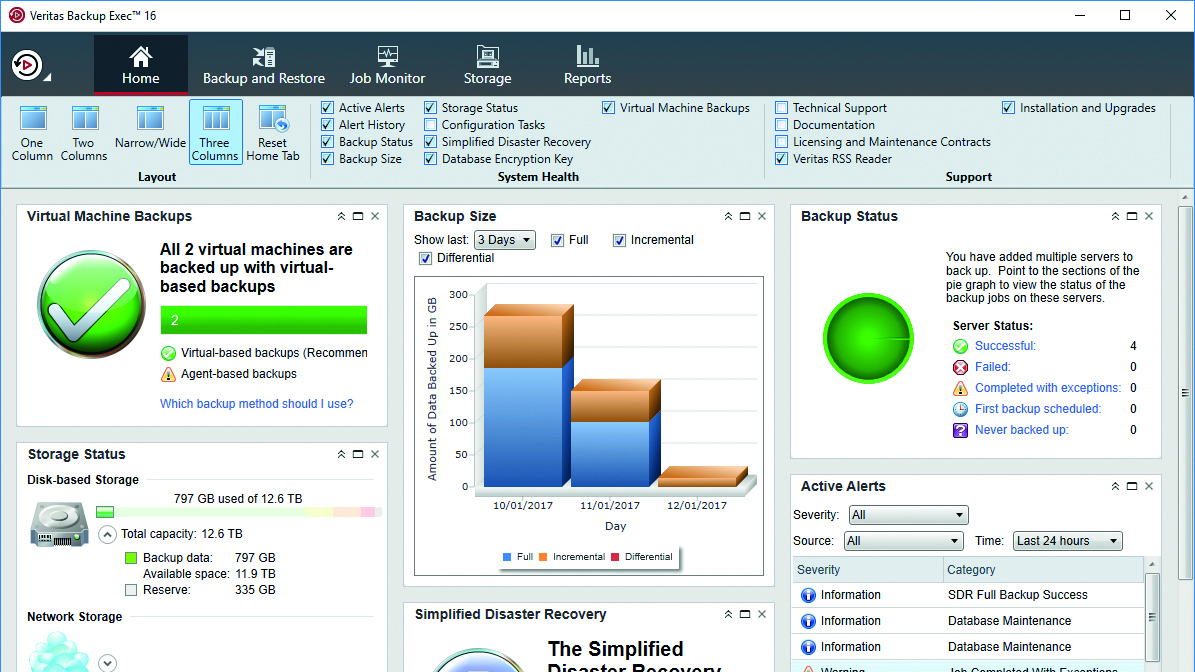Veritas Backup Exec 16 review
A simple backup suite offering affordable capacity-based licences and support for Windows Server 2016


If you’re after a do-it-all backup solution, Backup Exec 16 is the choice. It makes light work of managing a company-wide backup and recovery strategy, and the Capacity Edition licence is affordable.
-
+
Easy setup; Robust feature-set; Good value
-
-
No deduplication, multi-drive tape libraries, Linux server protection or NDMP support

Veritas acquired Backup Exec from Symantec in 2015, and it hasn't dragged its heels when it comes to updates: the software comes with full support for Windows Server 2016's core server operations. That's in addition to support for cloud providers including Microsoft Azure and Amazon S3, allowing businesses to easily migrate data off-site and manage it from the same console. The new Instant Granular Recovery Technology (GRT) speeds up data recovery from VMs too, and it's also ready to go with vSphere 2016.
Another welcome change from the Symantec days is a less tangled licensing scheme. Veritas now offers a simple choice of Capacity or V-Ray licensing - the latter being designed for virtual environments, and charged for on a per-socket basis. For most SMBs, the Capacity Edition Lite is the place to begin, starting with 1TB of front-end storage and most features: all that's missing is multi-drive tape libraries, deduplication, NDMP support and Linux server protection.
As advertised, BE16 worked fine with our Windows Server 2016 host system, and we had it loaded and ready in 30 minutes. The central console has seen a few minor cosmetic changes since the last release, and opens with a customisable dashboard offering a choice of widgets showing details such as job status, VM backups, storage usage and alerts.
We started by defining our backup storage - you can choose from disk, cloud, tape or pools. Disk-based storage options can include standard hard disks, deduplicating stores, network shares and removable devices such as RDX cartridges.
We also had no problems setting up Amazon S3 as a cloud backup destination. Choosing the network storage option, we had to provide our account ID and key, pick a bucket and decide on the number of simultaneous write operations to permit.
From the console, we then pushed agents to our Server 2016, Server 2012 R2, Hyper-V, Exchange 2013 and SQL Server 2014 systems. The latter two were running as VMs, but this was no problem: the routine pushed agents to them for us when we selected the Hyper-V host system.
Backup operations are further simplified by BE16's resource-centric model. This speeds up the creation of protection plans by reducing the number of steps required and makes it easier to include multiple backup stages using different media.
Each job starts with a full backup followed by daily incrementals, but this is easy to edit. You can change backup sources, destinations and schedules, replace incrementals with differentials and add extra migration stages such as tape or cloud storage. One caveat here is, if you want a job to use a specific disk backup device, BE16 defaults to using any available device. It's easy to change this, however. VMware fans can also have backups converted to VMs on completion.
To secure our Exchange and SQL Server VMs, we simply needed to create a job for the Hyper-V host server with these VMs selected. Here the Instant GRT feature really showed its worth: we could delve into our VM backups and swiftly pluck out individual files, folders, SQL databases, Exchange data stores and mailbox items to restore.
All recovery tasks are simple, as the job restore window only displays the relevant data for the system. The Exchange Restore wizard is a winner, providing one-click options to restore the entire database or mailbox items, along with a search facility for finding an email, contact or calendar item.
If you're after a do-it-all backup solution, Backup Exec 16 is the choice. It makes light work of managing a company-wide backup and recovery strategy, and the Capacity Edition licence is affordable.
This review originally appeared in PC Pro issue 271
Verdict
If you’re after a do-it-all backup solution, Backup Exec 16 is the choice. It makes light work of managing a company-wide backup and recovery strategy, and the Capacity Edition licence is affordable.
Get the ITPro daily newsletter
Sign up today and you will receive a free copy of our Future Focus 2025 report - the leading guidance on AI, cybersecurity and other IT challenges as per 700+ senior executives
Dave is an IT consultant and freelance journalist specialising in hands-on reviews of computer networking products covering all market sectors from small businesses to enterprises. Founder of Binary Testing Ltd – the UK’s premier independent network testing laboratory - Dave has over 45 years of experience in the IT industry.
Dave has produced many thousands of in-depth business networking product reviews from his lab which have been reproduced globally. Writing for ITPro and its sister title, PC Pro, he covers all areas of business IT infrastructure, including servers, storage, network security, data protection, cloud, infrastructure and services.
-
 Westcon-Comstor and Vectra AI launch brace of new channel initiatives
Westcon-Comstor and Vectra AI launch brace of new channel initiativesNews Westcon-Comstor and Vectra AI have announced the launch of two new channel growth initiatives focused on the managed security service provider (MSSP) space and AWS Marketplace.
By Daniel Todd Published
-
 Third time lucky? Microsoft finally begins roll-out of controversial Recall feature
Third time lucky? Microsoft finally begins roll-out of controversial Recall featureNews The Windows Recall feature has been plagued by setbacks and backlash from security professionals
By Emma Woollacott Published
-
 The UK government wants quantum technology out of the lab and in the hands of enterprises
The UK government wants quantum technology out of the lab and in the hands of enterprisesNews The UK government has unveiled plans to invest £121 million in quantum computing projects in an effort to drive real-world applications and adoption rates.
By Emma Woollacott Published